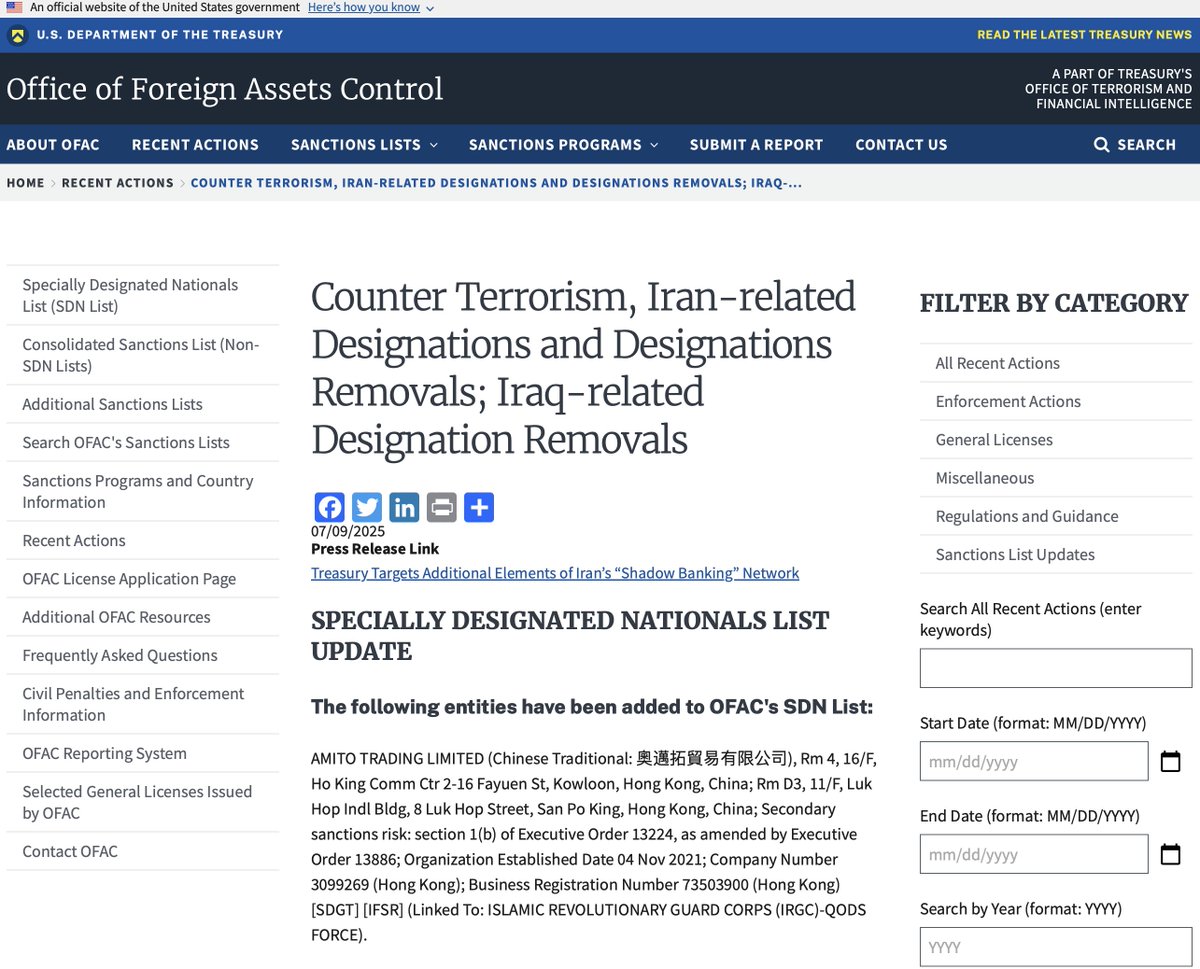[GUEST ACCESS MODE: Data is scrambled or limited to provide examples. Make requests using your API key to unlock full data. Check https://lunarcrush.ai/auth for authentication information.]  Naxe Carxer [@NaxeCarxer](/creator/twitter/NaxeCarxer) on x 13.7K followers Created: 2025-07-09 16:46:20 UTC IQD If you read this carefully, you would know how close we are. X. Removal of Iraq-Related Sanctions The July 09, 2025, OFAC update removing Iraq-related designations marks a U.S. policy shift, likely lifting prior restrictions on financial transactions and trade (e.g., remnants of the 2010-lifted Iraq Stabilization Sanctions). U.S. businesses can now engage more freely with Iraq, barring compliance with laws like anti-money laundering rules. Ernest Henderson, @ernn37, correctly notes sanctions ended in January 2025, with July formalizing this. X. New Tariffs on Iraq and Other Countries The U.S. imposed a XX% tariff on Iraq (plus XX% on Libya, XX% on Brunei, XX% on Algeria, XX% on Moldova, XX% on Philippines) on July 09, 2025, part of a broader tariff policy (NYT notes Trump’s re-entry "barrage"). This tax on imports raises costs for Iraqi goods (e.g., oil, key in the $XXX billion 2024 U.S. trade deficit per potentially reducing U.S. demand unless exporters adjust prices. X. Implications for Trading with the United States Increased Costs and Reduced Trade: The XX% tariff makes Iraqi goods less competitive vs. tariff-exempt countries (e.g., Canada, Mexico under USMCA), risking lower U.S.-Iraq trade despite post-2010 resilience. Negotiation Opportunities: The NYT mentions talks with Japan/EU to avoid tariffs, suggesting Iraq could seek exemptions given improved relations post-sanctions. Trade Pattern Shifts: Iraq may redirect exports to markets like China or India (per ScienceDirect’s U.S.-China example), diversifying its economy but reducing U.S. access. X. Currency Exchange and the Ability to "Exchange Very Soon" The Georgetown study shows sanctions weaken currencies; with sanctions lifted, the Iraqi dinar (IQD) could stabilize or rise vs. the USD, though the XX% tariff may reduce export inflows, risking depreciation unless offset by oil prices or investment. ScienceDirect notes tariffs can shift exchange rates (e.g., USD appreciation, IQD depreciation), depending on central bank actions. Exchange between USD and IQD is now feasible post-sanctions, - [[[ likely within days/weeks ]]] - as banks update systems, though tariffs may limit trade-driven volumes. $IQD $XRP $RLUSD  XXXXXX engagements  **Related Topics** [iraq](/topic/iraq) [marks](/topic/marks) [iraqi dinar](/topic/iraqi-dinar) [Post Link](https://x.com/NaxeCarxer/status/1942988701841203344)
[GUEST ACCESS MODE: Data is scrambled or limited to provide examples. Make requests using your API key to unlock full data. Check https://lunarcrush.ai/auth for authentication information.]
 Naxe Carxer @NaxeCarxer on x 13.7K followers
Created: 2025-07-09 16:46:20 UTC
Naxe Carxer @NaxeCarxer on x 13.7K followers
Created: 2025-07-09 16:46:20 UTC
IQD
If you read this carefully, you would know how close we are.
X. Removal of Iraq-Related Sanctions
The July 09, 2025, OFAC update removing Iraq-related designations marks a U.S. policy shift, likely lifting prior restrictions on financial transactions and trade (e.g., remnants of the 2010-lifted Iraq Stabilization Sanctions). U.S. businesses can now engage more freely with Iraq, barring compliance with laws like anti-money laundering rules.
Ernest Henderson, @ernn37, correctly notes sanctions ended in January 2025, with July formalizing this.
X. New Tariffs on Iraq and Other Countries
The U.S. imposed a XX% tariff on Iraq (plus XX% on Libya, XX% on Brunei, XX% on Algeria, XX% on Moldova, XX% on Philippines) on July 09, 2025, part of a broader tariff policy (NYT notes Trump’s re-entry "barrage").
This tax on imports raises costs for Iraqi goods (e.g., oil, key in the $XXX billion 2024 U.S. trade deficit per potentially reducing U.S. demand unless exporters adjust prices.
X. Implications for Trading with the United States
Increased Costs and Reduced Trade: The XX% tariff makes Iraqi goods less competitive vs. tariff-exempt countries (e.g., Canada, Mexico under USMCA), risking lower U.S.-Iraq trade despite post-2010 resilience.
Negotiation Opportunities: The NYT mentions talks with Japan/EU to avoid tariffs, suggesting Iraq could seek exemptions given improved relations post-sanctions.
Trade Pattern Shifts: Iraq may redirect exports to markets like China or India (per ScienceDirect’s U.S.-China example), diversifying its economy but reducing U.S. access.
X. Currency Exchange and the Ability to "Exchange Very Soon"
The Georgetown study shows sanctions weaken currencies; with sanctions lifted, the Iraqi dinar (IQD) could stabilize or rise vs. the USD, though the XX% tariff may reduce export inflows, risking depreciation unless offset by oil prices or investment.
ScienceDirect notes tariffs can shift exchange rates (e.g., USD appreciation, IQD depreciation), depending on central bank actions.
Exchange between USD and IQD is now feasible post-sanctions, -
[[[ likely within days/weeks ]]]
- as banks update systems, though tariffs may limit trade-driven volumes.
$IQD $XRP $RLUSD

XXXXXX engagements
Related Topics iraq marks iraqi dinar